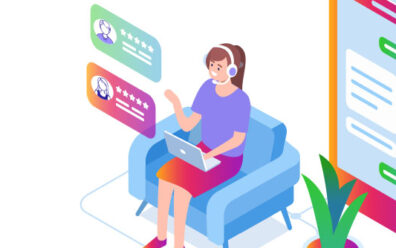Call Center Outsourcing3.5-minute read
Remote Work Turns Work Upside Down
As we near the end of 2020, the coronavirus pandemic wears on as business keeps on. The virus forced us all to work in different ways and in virtual spaces. And for many businesses, remote or at-home work prevails as a survival strategy to sustain operations. With it, comes an age of digital Darwinism of ones still standing and those that disappear.

At the outset, companies big and small wondered: Do we have the right technology to support our virtual workforce? How do we oversee our teams? And will they be productive?
Today, nearly a year into the new normal, many companies and workers are wondering how to and if they should make these work-from-home arrangements permanent.
Window into Working Remote

Source: www.shutterstock.com
Author: fizkes
A recent poll of workers in the U.S., U.K., Germany, Japan and Australia commissioned by Slack, an internet messaging company, provides a good window into the thinking about the future of remote work.
Some of the findings were:
- Knowledge workers are generally more satisfied working from home than being in the office (+9.2).
- The biggest increases in satisfaction are in work-life balance (+25.7), working arrangement (+20.1), managing work-related stress and anxiety (+17.3) and productivity (+10.7). Sense of belonging, however, was rated worse (-5).
- American mothers scored work-life balance (+12) considerably lower than mothers outside the U.S. (+20.4), possibly because of less access to child care.
Looking beyond the findings, it shows that excessive meetings actually undercut a worker’s sense of belonging. Those who attend weekly status meetings felt worse during the pandemic (-2.7) while those who only received status updates “asynchronously through digital channels” felt more belonging (+5.8). It’s not surprising that people prefer less micromanaging.
And for people not traditionally well-represented in the workplace, virtual is actually better. The findings state that historically underrepresented workers valued the remote experience more highly than their white colleagues. These same groups actually reported an increased sense of belonging with remote work—Black (+8.4), Asian (+7.6), Hispanic (+5.2)—while white workers reported a lower sense of belonging (-1.3).
An Upside in Down Times

Source: www.shutterstock.com
Author: GaudiLab
Certain workplace data stemming from this crisis is surprisingly upbeat, and resourceful companies are responding well as they soldier through it.
Recent Stanford research found:
- 42 percent of the U.S. labor force is now working from home full-time.
- Work-from-home employees now generate more than two-thirds of U.S. economic activity.
- 51 percent of the survey respondents–mostly managers, professionals and financial workers who can carry out their jobs on computers–reported being able to work from home at an efficiency rate of 80 percent or more.
- 65 percent of Americans reported having fast enough internet capacity to support workable video calls.
What’s more, many companies adjusted their operations to accommodate remote workforces.
Facebook and Google extended their work-from-home policies until the summer of 2021. Twitter and Square then went above and beyond to say workers could stay home “forever.”
Virtual is viable with the right processes, professionals and performance metrics in place. Being remote, in fact, requires companies to be more focused, disciplined in their operations and to run leaner, too.
As such, the pandemic forces businesses to re-assess everything—from eliminating layers of management to contracting workers to reducing office space. While the monumental shift to remote work caused by the pandemic shocked even us, it is how our company has operated since its inception more than 24 years ago. We launched our work-from-home model then, and today, it’s helped us maintain business operations during these troubling times.
For those looking to make the change to work-home-home or wanting their workforce operations to be more efficient, we’ve put together a working-from-home eBook to make the transition and continuation smoother and more successful.
Contact us today to consult with one of our business continuity experts.
Let's connect.
This Might Interest You...
This website uses cookies to personalize and improve your experience. Continue browsing our site if you agree to our Cookie Policy or feel free to Manage Cookies yourself.


